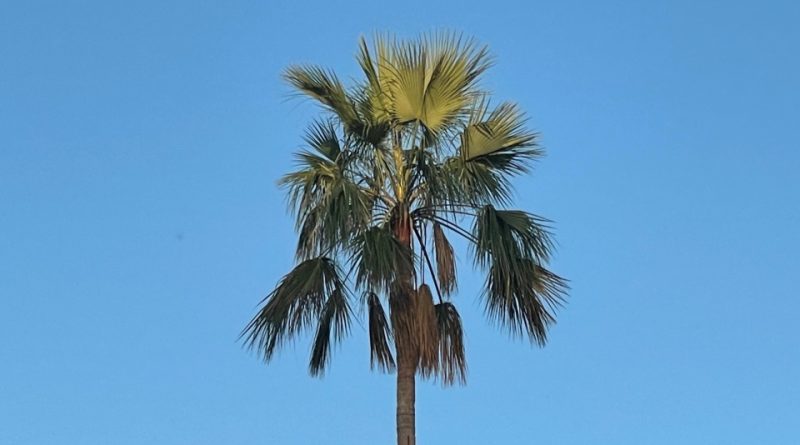Brahea brandegeei
Brahea brandegeei
The San Jose Hesper palm (Brahea brandegeei (Purpus) H.E.Moore, 1975) is an arboreal species belonging to the Arecaceae family.
Systematics –
From a systematic point of view it belongs to:
Eukaryota domain,
Kingdom Plantae,
Subkingdom Tracheobionta,
Spermatophyta superdivision,
Magnoliophyta division,
Class Liliopsida,
Arecales Order,
Arecaceae family,
Subfamily Coryphoideae,
Tribe Livistoneae,
Genus Brahea,
Species B. brandegeei.
The term is basionym:
– Erythea brandegeei Purpus;
The terms are synonyms:
– Centaurium brandegeei (Purpus) Druce;
– Erythea brandegeei Purpus;
– Erythea brandegeei var. spiralis M.E.Jones;
– Erythraea brandegeei Purpus;
– Glaucothea brandegeei (Purpus) I.M.Johnst..
Etymology –
The term Brahea is dedicated to the Danish astronomer Tycho Brahe (1546-1601).
The specific epithet brandegeei is in honor of the American engineer and botanist Townshend Stith Brandegee (1843-1925) who was long associated with the UC Berkeley Herbarium.
Geographic Distribution and Habitat –
Brahea brandegeei is a palm native to Baja California (northwestern Mexico).
Its natural habitat is that of mountain slopes and in rocky canyons where water is present, at medium altitude.
Description –
Brahea brandegeei is a single-stem palm growing to about 15 m in height.
The stem has a diameter of 30-40 cm, of a greyish brown color partially covered by persistent dry leaves.
The leaves are costapalmate and have a green color on the upper side and glaucous green on the lower side; they are 1-1,4 m broad, divided for about the half of the length in thin rigid segments, bifid at the apex; the petiole is 1-1,3 m long and about 3 cm broad in the median part, irregularly tomentose near the base, with margins provided with robust pale yellow spines about 0,6 cm long.
The inflorescences form between the leaves; they are slightly shorter than the same, arched, branched, with creamy white hermaphrodite flowers.
The anthesis is in late spring.
The fruits are oblong-globose in shape, 1,5-2,2 cm long, when ripe, of a glossy brown color at times with paler streaks, edible, when still immature and of a yellowish colour.
Cultivation –
Brahea brandegeei is a warm climate loving palm of most inland and desert areas of Southern California.
This palm is resistant to drought, to the extreme heat of the desert and can be cultivated in tropical, subtropical and warm temperate climate zones, where it seems as an adult it can resist temperatures down to about -8 °C for a very short time, but the foliage is already damaged around -4/-5 °C.
It is a plant that requires full sun and excellent drainage, for the rest it adapts to poor, alkaline soils, and as an adult it can bear long periods of drought, but takes advantage of regular watering, especially in the juvenile phase, in areas characterized by long summers hot and dry; it does not like excessively humid climates, even if it is among the most tolerant of the genus from this point of view.
It prefers sandy soils in sunny locations where it has the best growing conditions.
The palm has a moderate growth rate of about 18-23 cm per year.
It reproduces by seed which germinates in 3-6 months in optimal climatic conditions.
Customs and Traditions –
The Brahea brandegeei is a palm that is known by various common names, such as: Brandegee palm, San José hesper palm (English); palmier de Brandegee, palmier de San José (French); palma de taco, palma negra, palmilla (Spanish – Mexico).
The fruits of this palm are consumed that have a taste similar to that of dates, and consumed by the local populations who call them “tacos”.
Furthermore, it is considered among the most ornamental of the genus, of relatively fast growth, it is still little cultivated probably due to a certain resemblance to the Washingtonia robusta, faster growing and more available.
The leaves of this palm can be used to make handicrafts such as baskets, rugs, and other woven items. This type of handicraft is traditional in some cultures and can be a source of income for some local communities.
In some traditional cultures, certain parts of the plant, such as the young heart of the palm, may be used as a food source. Also, the wood from the trunk can be used to build simple structures.
Method of Preparation –
The Brahea brandegeei is a less known and used palm than others, of which, however, the fruits that are consumed by the local populations who call them “tacos” are consumed.
The so-called palm hearts can also be used from this palm, while leaves and wood have been used for simple artifacts and structures.
Guido Bissanti
Sources
– Acta Plantarum – Flora of the Italian Regions.
– Wikipedia, the free encyclopedia.
– GBIF, the Global Biodiversity Information Facility.
– Useful Tropical Plants Database.
– Conti F., Abbate G., Alessandrini A., Blasi C. (ed.), 2005. An annotated checklist of the Italian vascular flora, Palombi Editore.
– Pignatti S., 1982. Flora of Italy, Edagricole, Bologna.
– Treben M., 2000. Health from the Lord’s Pharmacy, Advice and experiences with medicinal herbs, Ennsthaler Editore.
Photo source:
– https://inaturalist-open-data.s3.amazonaws.com/photos/164668038/original.jpg
– https://swbiodiversity.org/imglib/h_seinet/seinet/ASU/ASU0003/ASU0003501_lg.jpg
Attention: The pharmaceutical applications and alimurgical uses are indicated for informational purposes only, they do not in any way represent a medical prescription; we therefore decline all responsibility for their use for curative, aesthetic or food purposes.


